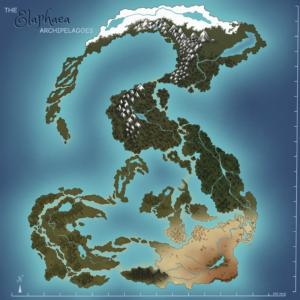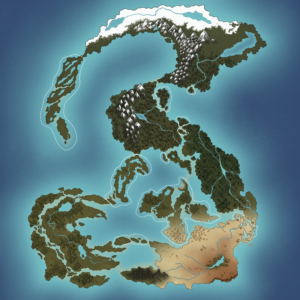The Shattered Isles
The Shattered Isles are the Southwestern most Isles of the Archipelago. Once one large land mass, torn apart during the blood moon war. This island’s territory is mostly based on eastern and south eastern Asia.
Flora and fauna of this territory take after those present in Japan and South Korea, with influences from Thailand and Vietnam.
Generally, the climate is mild. It can be characterized as monsoonal with some humid and subtropical areas. Sunhigh is often prone to sudden onslaughts of heavy rainfall, while Frostfall can be extremely cold and snowy.
The largest dangers this herd face are in the form of predators such as the Indochinese tiger, who often prey upon young fawns. Frosthold can also be dangerous, as the temperatures can drop below -20 Celsius.
The Shattered Island borders only the Desert Isle, and they have generally acceptable relations with their neighbors. Because many isles exist between the two territories, border skirmishes are a foreign concept, and true fighting has not happened for centuries.
The other herds are generally regarded with equanimity, neither with favor or with hatred. Though, they may be seen as lesser in terms of self-control and mastery.
See Mirroweld Locations for more information!
The Desert Isle
The Desert is massive and all encompassing, taking up at least 80% of the island’s land mass. The golden sand has a red hue to it when it whips up in the winds and glimmers a faint ruby shade even when settled in massive dunes. To a phae unfamiliar with the landscape, this sea of sand is a death sentence. Water is nearly non-existent and to get lost in the changing tide of gold and red is a mistake you can not afford to make.
Snaking its way from the north a massive river cuts its way through the red clay and sand. From this river springs not only life but greenery in great amounts. Palms and even modest forests grow from where the water remains the most reliable, making small oases in some places and even growing into rapids in others. Halfway through the river it widens, amassing into a large lake that is a reliable water source year round. From this lake the heart of the herd beats. Despite the changing weather, dry and wet seasons, water can always be found here.
It’s from the lands surrounding the river the Primary rules and the expansive capital city lies. The vast majority of the population lives here, crafting, building and living their lives amidst the flood of color and the city’s vivacity. Surrounded in fertile ground and modest forest, the phae here have learnt to work with what the land provides and mastered it.
The river still provides opportunities for many, both north and south. Farmers find these lands the most desirable as the yearly flooding of the river brings fertile soil over the banks of the river and allows for crops to be planted and grown!
The weather around the Great River is dependable, usually never too hot thanks to the cooling water but prone to flooding in the rainy season. The desert itself is scorching hot during the day and a poorly prepared traveler can cook in a matter of hours.
At night, the desert plummets into near freezing temperatures. Phae blessed with fire magic are essential in open areas to survive the freeze. Shelter can sometimes be found in rocky, red stone mountains and outcroppings of rock but only to those who know where to look.
See Dawnspire Locations for more information!
The Mountain Isle
Nearly half of the Mountain Isle is occupied by the magnificent Ironcrag mountain range. These peaks may exceed 3,000 meters, while the tallest peak, Elderfrost, peaks at around 4,500 meters. Much of the mountain range has an alpine-like climate, with harsh, cool to cold weather year round. The tallest mountain peaks have snow year-round, and in Frosthold the snow line nearly reaches the lowlands. Frosthold is frigid in the mountains with temperatures plummeting well below zero celsius. Even in Sunhigh, though, the temperature will rarely climb higher than 16 celsius. The highest parts of the mountain peaks are some of the most dangerous on the island, as the air quickly becomes thin and phae need to be sure to rest and take their time as they climb.
The lower lands of Mountain isle are much calmer and have a comparatively milder climate than the mountain range. The climate is far more similar to a temperate forest, with dense coverage of pine trees near the foothills of the mountain. Maple, walnut, and birch trees are spread across much of the rest of the island. The land is shared between moors, small open plains, and forests. In Rainfall, the moors spring to life with colorful wildflowers, heather, and lavender. Temperatures range from a high around 32 celsius in Sunhigh to -32 celsius in Frosthold. Over the course of the year, the island can easily receive anywhere from 100 – 150 centimeters of rain and snow.
The southernmost point of the island close to Jungle isle has a combination of temperate forest and temperate rainforest climate. Many trees in this area are moss covered, and an ancient grove of redwood trees stretch into the skies.
The western coast of the island is left exposed to the brutal winds from the sea, and many rocky, craggy cliffs line this region of the island. The beaches there are usually chilly, and have coarse, rocky sand lining their shores.
Much of the Mountain isle has a similar climate to the Pacific Northwestern United States, with a smattering of influence from alpine and boreal climates as well. As such, many animals found here have thick, warm coats necessary to survive the freezing temperatures of Frosthold. Many of these animals also have coats that shift colors depending on the temperature and season. Among the carnivorous animals are wolves, red foxes, bears, coyotes, bobcats, mountain lions, and eagles. Other animals include owls, otters, martins, beavers, rabbits, hares, skunks, squirrels, raccoons, some snakes, ravens, crows, and hummingbirds. Along the shores and in the sea, phae might also find sea otters, sea lions, seals, porpoises, orcas, baleen whales, and the occasional walrus in the north.
See Stonemire Locations for more information!
The Jungle Isle
Located to the far east of the Archipelago, the thickly jungled isle is a large, single island without too much variation in geography. There are some higher climbs and some small mountains that boast spectacular cloud forests, but the vast majority of the island remains at around the same elevation. There are some smaller islets bordering it to the west, one of which holds a stony mountain surrounded by dense, bioluminescent foliage. With a climate similar to the Amazon, it is hot and humid year round, with seasonal heavy rainfall and dryer spells towards Frosthold and Sunhigh, respectively.
The jungle is filled to the brim with tropical plants, insects, birds, amphibians, and other flora and fauna, both benevolent and hostile. With jaguars, anacondas, harpy eagles, giant anteaters, maned wolves, and caimans, there is no shortage of danger. That also says nothing of the dangerous plants and poisonous snakes and amphibians that inhabit the island as well. It can be lethal to the uninitiated, but thankfully, the locals are fairly adept at dealing with the threats of their homeland.
See Vinelocke Locations for more information!
The Tundra Isle
Located at the northernmost reaches of the isles, the Tundra isle occupies arguably the largest island, although much of it is covered by snow for a good portion of the year. Although almost all of the isle is charted, only a few select areas are actively inhabited. Safety, in numbers, as they say; but even so, there is no shortage of known places in the holds.
Much of the northern reaches are frequently covered in snow, but in Rainfall and Sunhigh, it becomes a bountiful paradise of rolling grass, tundra scrub, wildflowers, and vibrant life. In Leafturn and Frosthold, the grass fades, the land freezes, deep snow covers it, and the farthest northern shores become covered in thick sea ice.
To the south of the isle are great evergreen forests, with intermittent deciduous trees here and there in groves a bit farther to the south and in the foothills of the mountains. This woodland is mostly safe during the warmer months, but becomes deadly not only for the deep drifts and wells beneath trees in the colder ones, but for the wolves that like to stalk these lands as well. There are many a dedicated path through the trees here, but it is best not to tarry when the weather is cold.
The most notable feature here, aside from the tundra, are the three massive freshwater lakes. Two lakes connect through a deep and cold river fed by snowmelt in the north, and to the southeast, an even larger lake resides, fed by glacial runoff from the Cloudback Mountains.These lakes all play host to very unique life, such as freshwater seals and porpoises.
Despite its harshness, a great abundance of life thrives here.
See Helmfirth Locations for more information!
Unaffiliated Islands
There are many neutral islands across the Archipelagos, some left unclaimed entirely or agreed upon as neutral by wars of the past by all of the herds. Typically, Renegades set up homes here or those looking to form splinter herds might come into a dispute with others if they can gain enough in numbers to make a true claim of the land toward the other herds.
The largest unaffiliated land masses are those between the shattered isles, desert isle, jungle isle, and the mountain isle (not all, see herd locations for the islands claimed by a herd). Aside from this, the Westernmost ‘tail’ of the Tundra Isle also remains as neutral territory.
See some of the unaffiliated Islands below!

